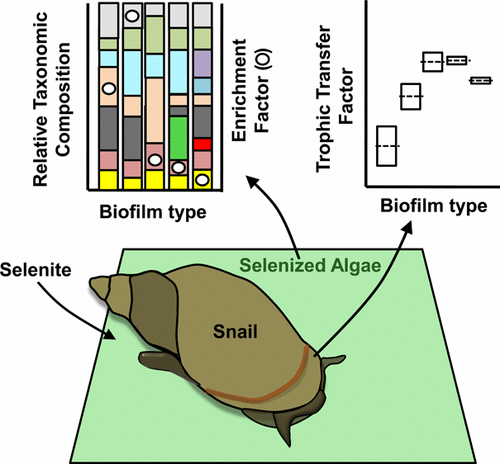当前位置:
X-MOL 学术
›
Environ. Sci. Technol.
›
论文详情
Our official English website, www.x-mol.net, welcomes your
feedback! (Note: you will need to create a separate account there.)
Genetic Characterization of Periphyton Communities Associated with Selenium Bioconcentration and Trophic Transfer in a Simple Food Chain
Environmental Science & Technology ( IF 10.8 ) Pub Date : 2017-06-14 00:00:00 , DOI: 10.1021/acs.est.7b01001 Vanessa Friesen 1 , Lorne E. Doig 2, 3 , Blue E. Markwart 2 , Monique Haakensen 1 , Emily Tissier 1 , Karsten Liber 2, 4
Environmental Science & Technology ( IF 10.8 ) Pub Date : 2017-06-14 00:00:00 , DOI: 10.1021/acs.est.7b01001 Vanessa Friesen 1 , Lorne E. Doig 2, 3 , Blue E. Markwart 2 , Monique Haakensen 1 , Emily Tissier 1 , Karsten Liber 2, 4
Affiliation

|
A major source of uncertainty in predicting selenium (Se) distribution in aquatic food webs lies in the enrichment factor (EF), the ratio of Se bioconcentration in primary producers and microorganisms relative to the concentration of Se in the surrounding water. It has been well demonstrated that EFs can vary dramatically among individual algal taxa, but data are lacking regarding the influence of periphyton community composition on EFs for a given geochemical form of Se. Therefore, the goals of this study were first to assess whether different periphyton communities could be established in aquaria with the same starting inoculum using different light and nutrient regimes, and second, to determine if the periphyton assemblage composition influences the uptake of waterborne Se (as selenite) and subsequent Se transfer to a model macroinvertebrate primary consumer. Periphyton biofilms were grown in aquaria containing filtered pond water (from Saskatoon, SK) spiked with approximately 20 μg Se/L (mean measured concentration 21.0 ± 1.2 μg Se/L), added as selenite. Five different light and nutrient regimes were applied to the aquaria (three replicates per treatment) to influence biofilm community development. After 6 weeks of biofilm maturation, 40 to 80 immature cultured snails (Stagnicola elodes) were added to each aquarium. The bacterial and algal members of the periphyton community were characterized by targeted metagenomic analyses before and after addition of snails to ensure the snails themselves did not significantly alter the biofilm community. Samples were collected for Se analysis of water, periphyton, and whole-body snail. The nutrient and light treatments resulted in substantially different compositions of the periphytic biofilms, with each being relatively consistent across replicates and throughout the study. Although the aqueous concentration of dissolved Se administered to treatments was constant, uptake by the different periphytic biofilms differed significantly. Both the low-light (61.8 ± 12.1 μg Se/g d.w.) and high-light (30.5 ± 4.7 μg Se/g d.w.) biofilms, which were found to have high proportions of cyanobacteria, contained statistically higher concentrations of Se relative to the other treatments. Furthermore, the concentration of Se in bulk periphyton was predictive of Se bioaccumulation in grazing snails but as an inverse relationship, opposite to expectations. The trophic transfer factor was inversely correlated with periphyton enrichment factor (r = −0.841). A number of different bacterial and algal taxa were correlated (either positively or negatively) with Se accumulation in periphyton biofilm and snails. Recent advancements in genetic methods make it possible to conduct detailed characterization of periphyton assemblages and begin to understand the influence that periphyton composition has on Se biodynamics in aquatic systems.
中文翻译:

简单食物链中硒生物富集与营养转移相关的附生植物群落的遗传特征
预测水食物网中硒(Se)分布的不确定性的主要来源在于富集因子(EF),主要生产者和微生物中硒的生物浓度与周围水中硒浓度的比值。业已充分证明,EFs在各个藻类群中可能会发生巨大变化,但是对于给定的地球化学形式的Se,缺少关于浮游植物群落组成对EFs影响的数据。因此,这项研究的目的首先是评估是否可以使用不同的光照和养分方案在具有相同起始接种物的水族箱中建立不同的附生植物群落,其次,确定周生植物组合物的组成是否影响水硒(亚硒酸盐)的吸收以及随后硒向模型无脊椎动物主要消费者的转移。附生生物膜在含有过滤后的池塘水(来自萨斯卡通,SK)的水族箱中生长,掺入约20μgSe / L(平均测得浓度为21.0±1.2μgSe / L),并添加为亚硒酸盐。将五种不同的光照和养分方案应用于水族箱(每次处理重复三遍),以影响生物膜群落的发育。生物膜成熟6周后,培养了40至80只未成熟的蜗牛(将五种不同的光照和养分方案应用于水族箱(每次处理重复三遍),以影响生物膜群落的发育。生物膜成熟6周后,培养了40至80只未成熟的蜗牛(将五种不同的光照和养分方案应用于水族箱(每次处理重复三遍),以影响生物膜群落的发育。生物膜成熟6周后,培养了40至80只未成熟的蜗牛(鼠尾草)添加到每个水族馆。在添加蜗牛之前和之后,通过针对性的宏基因组分析,对附生植物群落的细菌和藻类成员进行了表征,以确保蜗牛本身不会显着改变生物膜群落。收集样品进行水,水生植物和全身蜗牛的硒分析。营养和光处理导致了周围生物膜的成分明显不同,在重复实验和整个研究过程中,每种膜相对一致。尽管施用于治疗的溶解硒的水浓度是恒定的,但是不同的周生生物膜的吸收却有显着差异。低蓝光(61.8±12.1μgSe / g dw)和高蓝光(30.5±4.7μgSe / g dw)生物膜均被发现具有较高的蓝细菌比例,相对于其他处理,统计上含有较高的硒浓度。此外,大块附生植物中硒的浓度预示着放牧蜗牛中硒的生物富集,但与期望值成反比关系。营养传递因子与周生植物富集因子呈负相关(r = -0.841)。大量不同的细菌和藻类类群与硒在植物附生生物膜和蜗牛中的积累相关(正向或负向)。遗传方法的最新进展使得有可能对附生植物组合进行详细的表征,并开始理解附生植物组成对水生系统中硒生物动力学的影响。
更新日期:2017-06-28
中文翻译:

简单食物链中硒生物富集与营养转移相关的附生植物群落的遗传特征
预测水食物网中硒(Se)分布的不确定性的主要来源在于富集因子(EF),主要生产者和微生物中硒的生物浓度与周围水中硒浓度的比值。业已充分证明,EFs在各个藻类群中可能会发生巨大变化,但是对于给定的地球化学形式的Se,缺少关于浮游植物群落组成对EFs影响的数据。因此,这项研究的目的首先是评估是否可以使用不同的光照和养分方案在具有相同起始接种物的水族箱中建立不同的附生植物群落,其次,确定周生植物组合物的组成是否影响水硒(亚硒酸盐)的吸收以及随后硒向模型无脊椎动物主要消费者的转移。附生生物膜在含有过滤后的池塘水(来自萨斯卡通,SK)的水族箱中生长,掺入约20μgSe / L(平均测得浓度为21.0±1.2μgSe / L),并添加为亚硒酸盐。将五种不同的光照和养分方案应用于水族箱(每次处理重复三遍),以影响生物膜群落的发育。生物膜成熟6周后,培养了40至80只未成熟的蜗牛(将五种不同的光照和养分方案应用于水族箱(每次处理重复三遍),以影响生物膜群落的发育。生物膜成熟6周后,培养了40至80只未成熟的蜗牛(将五种不同的光照和养分方案应用于水族箱(每次处理重复三遍),以影响生物膜群落的发育。生物膜成熟6周后,培养了40至80只未成熟的蜗牛(鼠尾草)添加到每个水族馆。在添加蜗牛之前和之后,通过针对性的宏基因组分析,对附生植物群落的细菌和藻类成员进行了表征,以确保蜗牛本身不会显着改变生物膜群落。收集样品进行水,水生植物和全身蜗牛的硒分析。营养和光处理导致了周围生物膜的成分明显不同,在重复实验和整个研究过程中,每种膜相对一致。尽管施用于治疗的溶解硒的水浓度是恒定的,但是不同的周生生物膜的吸收却有显着差异。低蓝光(61.8±12.1μgSe / g dw)和高蓝光(30.5±4.7μgSe / g dw)生物膜均被发现具有较高的蓝细菌比例,相对于其他处理,统计上含有较高的硒浓度。此外,大块附生植物中硒的浓度预示着放牧蜗牛中硒的生物富集,但与期望值成反比关系。营养传递因子与周生植物富集因子呈负相关(r = -0.841)。大量不同的细菌和藻类类群与硒在植物附生生物膜和蜗牛中的积累相关(正向或负向)。遗传方法的最新进展使得有可能对附生植物组合进行详细的表征,并开始理解附生植物组成对水生系统中硒生物动力学的影响。

















































 京公网安备 11010802027423号
京公网安备 11010802027423号